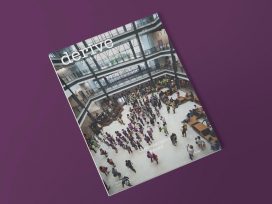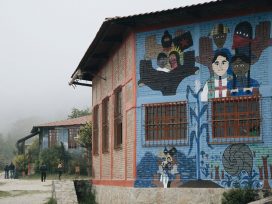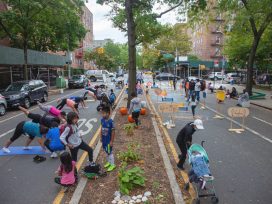Commons are a form of resistance against self-exploitation, isolation and the reduction of people to consumers, writes Brigitte Kratzwald. But this resistance isn’t about destroying what already exists: it’s about creative production geared to meeting people’s real needs.
Commons do not exist in themselves – they are created
The concept of “commons” describes a particular way of dealing with things – those things technically known as “common pool resources”. Commons therefore do not exist as things in their own right. Water is not a commons as such (it can also be bottled and sold in supermarkets, thus becoming a product), nor is the atmosphere, the earth’s raw materials or the world’s knowledge. But all these things and many more besides can become commons, so long as there are people to look after them collectively. So the question of what constitutes a commons is tricky to answer, since commons always involve three elements: a resource on the one hand; the people who produce, maintain and use the resource, also known as commoners; and the rules that people create for the resource. Commons are social arrangements and create a specific form of social relationships (cf. Helfrich 2012). This state of affairs is better expressed by a verb: “commoning”, the collective practice of the production, use and maintenance of commons. We can then in turn ask which people use which things as commons. This includes a wide variety of resources, of different things such as water supply facilities, forests and pasture land, houses and public spaces, gardens and cars, or free software and free wi-fi. Of course the same rules do not apply to all these different things. And yet commons operate differently everywhere, as commons researcher Elinor Ostrom has observed (cf. Ostrom 1990). The rules for the use of commons vary according to the specific characteristics of the resource as well as climatic and technical conditions and the culture in which the resources are produced. So there are no instructions for the use of commons, but there are many people throughout the world who nurture, use and constantly reproduce commons. They do this because they can fulfil their needs better when they communicate and cooperate with each other than they could independently, and they possess a huge wealth of experience that we can draw on.
Despite their wide variety, all commons follow a specific logic, one which is different from the logic of the market in a number of important aspects: commoners do not produce for money or for profit, but expressly to fulfil their needs. Everyone can contribute what they have, and are capable of doing, to the commons; the very variety of skills and needs means that commons are experienced as a space where plenty, not scarcity, is the rule. There is enough for everyone; everyone can contribute and make a difference. Lastly, there is another concept of property in the commons – or rather, a distinction is made between possession and property. Property, as it is nowadays understood in our legal framework, gives owners the right to dispose of their property as they please. The owner of a house can not only live in his house or rent it out to others; he can also leave it empty and let it decay, have it demolished or make it the object of speculation. Possession, on the other hand, would mean that a person could use a house for as long as he needs it and indeed as he sees fit. Once he no longer needs it, however, he is obliged to hand it on to the next occupier. If the house is to be demolished, everyone in the surrounding area gets to have a say, and if no one wants to use it any more, they can come to a collective decision to have it torn down. Instead of exclusive rights to property, in the commons there are a variety of rights of use, so that no one can be denied the fulfilment of his needs and resources are not wasted or overused. But what has that got to do with resistance?
Commons change power relationships
The concept of resistance tends initially to conjure up images of street fights, police operations and violence. This first impression is not necessarily wrong – resistance does indeed often involve these elements. Yet effective resistance means much more than spontaneous, explosive outbursts of collective dissatisfaction – more than criticism and calls for revolution. Resistance, the notion of resisting, also entails a vision of how things could be – a vision of the good life, or at least a better one, and means of realizing that vision in the here and now. In today’s circumstances that could for instance mean resisting the temptations of consumer society as well as the excessive demands of the world of work; it can mean the refusal to submit to the pressure of having to be constantly available, of constantly having to prove oneself, to the pressures of efficiency, flexibility, innovation and all the other favourite buzzwords of the modern world.
Commons – or rather commoning, as the social practice of the collective reappropriation of living conditions – can be an important component in a resistance that is so understood, because people can thus become more independent of the market and the state, and less easy to govern. People who can take care of themselves no longer have to put up with everything. According to the Italian Marxist economist Massimo de Angelis, commons give people more power; not “power over” others, but “power to”, the power to reject the demands of the rulers, “the power to refuse”.
No commons without resistance, no resistance without commons
Commoning and resistance often go hand in hand and have a variety of different mutual relationships. The maintenance of commons can often only be achieved by resistance against so-called “enclosures”. Historically the right of commoners to resist enclosures was sometimes even established in law; consequently this resistance is part of commoning, and at times even a legal one.
On the other hand, commoning is part of almost every form of collective resistance. The very organization of demonstrations, protest meetings and camps and political campaigns demands a great deal of preparation, involving communication and cooperation between people who compare their needs and offer to contribute their various capabilities with a view to achieving a common goal. Processes of this kind can often, though not always, be a form of commoning. If the protest is of a longer-term nature, as with university occupations, climate camps or the Occupy movement, it becomes imperative that the organizers provide a level of basic services. Camps like this are almost the perfect example of temporary commons. In recent years yet another form of commons has played an important part in the organization of resistance movements: free media, open source software and free wireless networks.
Enclosures result not only from the assertion of capital rights, but also from governments pushing through measures to develop the market economy. Commons often disappear purely because their users no longer wish to take on the responsibility for producing and maintaining them, and succumb instead to the lure of the market or the state and the assurances that these can fulfil their needs better, more cheaply or more safely. This sometimes works, but rarely all the time, and inevitably leads in the longer term to new relations of dependency. So commoning also consists in resisting these temptations and promises.
Resistance as part of commoning
In feudal England every piece of land that unpropertied peasants were able to use to fulfil their basic needs had the legal status of a “commons”, even though it was in the possession of the nobility or of the king. The right to use of commons was first guaranteed in the Magna Carta in 1215. This legal charter also contained the right to maintain and defend commons. Once a year, the borders of “common land” would be paced out in so-called “perambulations”. At these events, which amounted to public festivals, the land would be demarcated and any walls or fences that had been set up in the intervening year could be torn down and levelled out (cf. Linebaugh 2008, 21 ff.)
By this time, commons were already places of resistance, where place can be understood in a dual sense.1 They were the physical site where people could gather together on a daily basis, which therefore gave them the opportunity to organize and form a resistance if the ruler behaved too despotically or the rights of commoners were too heavily constrained. At the same time they were a social and legal place of liberty, of relative independence from the feudal ruler, because they placed a limit on his power. The right to the use of commons was a law that enjoyed primacy over the ruler and to which even he was obliged to submit. This is a peculiarity of British common law contrasted with Roman law in the rest of Europe, which is guaranteed by the state or the government and so always involves the potential danger of the abuse of power. This law set a constraint on the landowner’s power of disposal and thus gave peasants a degree of autonomy, since they were able to make their own living without being dependent on others.
In contrast to most European countries, in England the status of “common land” exists to this day for land that cannot simply be sold or rededicated, but must be kept available for the public to use. If it is used for other purposes, other land of equal value must be rededicated as common land. This law was simply annulled in London before the Olympics in 2012, when a basketball court was to be built on a site identified as “common land”. The “New Lammas Lands Defence Committee”2 wasn’t able to prevent this, but the case began to reinforce awareness on the part of the government and the population as a whole of the significance of this form of law, and led to the reintroduction of “perambulations”, the regular inspection of those plots of land, which proved to be good publicity to boot. This all followed from the realization that commons will only remain in existence if they are actually used and actively maintained.
The implementation of capitalism was only made possible through the enclosure of what had historically been commons, which took away the basis of the peasants’ livelihood and forced them – after a long period of resistance, which also resulted in a number of civil wars – to enter service as labourers. These enclosures were not directly enforced by capital, but also by the governments of newly created states, which put their best efforts into supporting industrialization, because it fostered the rise of the bourgeoisie and weakened the power of the nobility and the king. In England, for instance, the royal family was for a time on the same side as the dispossessed peasants in relation to the so-called “parliamentary enclosures” – in which commons were privatized for the purpose of sheep-breeding – because it saw its own power being eroded (cf. Polanyi 1971.).
The misery of the early industrial proletariat is very familiar to us from literature by authors ranging from Charles Dickens to Karl Marx. This misery was alleviated by means of new commons which the working class created for itself. These ranged from early forms of insurance offering mutual protection to wholesale, housing and agricultural production collectives, which made workers less dependent on hired labour and state support, so strengthening their position in dealings with employers and politicians. The labour movement enjoyed its greatest success when it had its own strong supply structures established in the form of commons, as for example with the council system after World War I. The creation and use of commons was an important factor in successful industrial disputes. The social achievements of socialist-controlled “Red Vienna”, to give one example, were social democracy’s answer to the successful practices of collective organization in the labour movement, with a view to bringing them under control (cf. Exner / Kratzwald 2012, 54 ff.).
The European social state can ultimately be seen as a form of nationalization of the commons, which in some respects brought with it considerable advantages, while at the same time wresting back control from the working class and linking social protection to hired labour. Such social systems become repressive when there is insufficient wage labour available, particularly at times of economic crisis. However, the great success of this model in the period of growth following World War II led to the labour movement largely accepting this new arrangement of wage labour, private property, the market and supplementary employee benefits, acknowledging it as “better” and “more modern” and so putting an end to what remained of the subsistence economy.3 It was only thanks to this that the market system was able to achieve its dominance by extending its scope to ever more areas of society, and since then to reinforce that dominance further and further. The euphoria, nevertheless, was short-lived, as the first economic crises hit in the 1970s. Without its commons, the labour movement was too weak to prevent neoliberal restructuring programmes from being implemented, because it had made itself entirely dependent on wage labour and state redistribution. It was at this point that resistance in the shape of collectively organized initiatives and enterprises began to develop, as many people realized how important they were – as is often the case with commons when their absence becomes noticeable, and costly. In recent years since the global economic crisis there has been a new boom in such initiatives, and thanks to new media and new technologies their development is substantially more dynamic than it was twenty years ago. New forms of commoning, as a resistance against the hopelessness and repressive effect of a market fundamentalism that has got out of control, can now be observed across Europe.4
Resistance against the enclosure of commons remains part of the practice of commoning. Nonetheless, these are already examples of another aspect of commoning: commoning is, indeed, an inherent component in resistance movements.
Commons as part of resistance practices and movements
Austrians in the know will recall not only the successful resistance against the nuclear power plant in Zwentendorf, but moreover especially the equally successful occupation of the Hainburger Au in 1984. Environmentalists camped out over several weeks in the Au in wintry conditions and despite threats from the construction workers’ and loggers’ trade union to prevent illegal logging. Similar events took place in Gorleben in the Wendland as a protest against the construction of an nuclear waste disposal site, albeit with less success. Every dry-cask storage transportation of waste to this day becomes a case of running the gauntlet, as opponents of nuclear power congregate for several days or even weeks to set up a blockade of broken rocks – seeking to make the tracks impassable. Since the beginning of the anti-globalization movement at the end of the last century, resistance camps at a variety of WTO, EU and G8 summits have become the order of the day. In recent years there have been climate camps too, which seek on the one hand to draw the public’s attention to the threat posed by climate change and restrict activities harmful to the climate by for instance blockading an airport runway or the entrance to a power station, but equally to offer concrete alternatives. Pretty much anyone with an interest could name similar examples in their own region. Often it turns out to be people who have previously barely been politically active, inconspicuous bank employees or pensioners, who join in with this kind of activism – because things are happening in their immediate neighbourhood that they see as a threat. They demand their right to be consulted and have a say, as happened in Stuttgart with the protest against the rebuilding of the station. Whenever people not only make demands of politicians but assert their right to take an active role in shaping the world they live in, and are ready to take on responsibility for doing so, commoning becomes part of resistance.
All these forms of protest are only possible because communication, cooperation and the building of trust are paramount; also, because a shared temporary infrastructure is created that gives participants a degree of autonomy. Food and drink, overnight accommodation, sanitary facilities and for the most part social and medical care are all collectively provided. A focus of many camps and occupations is the pooling and collective development of people’s knowledge and abilities. Freedom from hierarchies, opportunities for participation, mutual respect and the valuing of all contributions are trademarks of this form of organization and make it an object lesson in effective commoning. The same processes are seen at work in university occupations and house squats (cf. Kratzwald 2009). Even if people go their separate ways after a few days or weeks with varying degrees of success, these experiences have a long-lasting effect – they make visions seem attainable and are an effective antidote to feelings of powerlessness or of a lack of alternatives.
The Occupy movement, which was born as a response to the financial and sovereign debt crisis, puts commoning, this form of collective organization without hierarchies, at the centre of its resistance. The oft-expressed criticism that the movement is not political, because it has no concrete, shared aims, misses the point. A far more fundamental criticism of the Occupy movement is that it does not take a stand against speculation on the financial markets, budget cuts or the bank bailouts – even if these things were the catalyst for the formation of the movement – and makes no demands of the state. What it does is challenge the entire duopoly of market and state: both the market and politicians are accused of being not only incapable of providing, but having no legitimacy to provide an adequate answer to today’s pressing questions. “If you have a demand, then you request it from a higher authority within the state. In so doing you accept the function and the very existence of this authority. That’s exactly what we’re not doing. […] The 99 per cent understand that the current political systems will not solve their problems, so they are shifting their focus” (Graeber, 2012). As they do so they are, consciously or subconsciously, invoking the values and principles of commoning.
The Arab Spring and the Gezi Park demonstrations in Istanbul also display all the characteristic traits of commoning. No protest movement can succeed without being able to independently take care of its basic needs, and all these movements advocate greater self-determination and more opportunities for participation.
Territories in resistance
Raúl Zibechi, in a book bearing the above title, describes how the inhabitants of favelas in several cities in Chile, Peru and Venezuela succeeded in establishing a functioning infrastructure that afforded them an adequate standard of living outside of the capitalist market. In areas that are not only of little interest to investors, but are actually situated beyond the reach of state institutions, economies are formed that Zibechi explicitly describes as “anti-capitalist”, following the logic of commons. Women play an important role in these economies, and their driving force is exclusively the provision of needs. The practice of self-sufficiency made it possible for these people even to survive military dictatorships, whereas the social policies of left-wing regimes generally proved fatal for them – the regimes would take these areas back under state control, at which point the state would once again take control of the provision of basic services. Zibechi manages to show how the interaction of “liberated” spaces and dissident practices allowed these people to preserve their independence from market and state for long periods, and thus to resist their temptations as well as their oppression.
James C. Scott describes a similar scenario in the Zomia region of south-east Asia (cf. Scott, 2009). Seven ethnic groups have succeeded in retreating to the hills and over a period of centuries have avoided being integrated into state territory. Such groups are generally viewed as pre-modern and primitive. Scott, in contrast, observes that these people have consciously shunned membership of a state and developed their own, non-governmental system. They use economic systems that enable them to fulfil their own needs as a collective, and for this purpose have chosen a region that for inherent geographical reasons makes state intervention problematic. Here too the close interrelation of territory and commoning can be seen – one which makes enduring resistance possible.
Resistance in everyday neoliberal life
Yet there are also much less spectacular ways in which people quite consciously practise forms of commoning. In the process they defy the standardization of all individuals, processes and relationships according to the dictates of neoliberal, capitalist exploitation logic. Commons are a form of resistance against self-optimization, self-exploitation, isolation and the culture of competition that now seem inescapable for anyone who wishes to succeed in life. They signify resistance against the omnipresence of commodification and the privileged status of private property, and resistance against the notion of people being reduced to the role of consumers. This resistance is not achieved by destroying what already exists, but by creativity in the establishment of alternatives and diligent care to preserve and defend them. This is done through energy cooperatives and agricultural solidarity projects, through communal gardens and self-governing cultural centres, through free software projects and swap shops, car-sharing and couch-surfing, public workshops and “fab labs”. Those who can make things themselves, or use them jointly with others, not only save resources but get plenty of things for free, thereby becoming less dependent on wage employment and state support – just like the peasants in medieval England. Free software and open source hardware represent a form of resistance against monopolies on communication, ubiquitous surveillance and planned obsolescence. Yet this resistance is not an end in itself, nor is it a lifestyle tailored to the individual. All these things only work through cooperation with others and have one objective in mind: a better life and a means of production that is socially just, ecologically sustainable and democratically taxable. The vehemence of the attacks on such initiatives once they have gained a certain level of traction is testament to the fact that this philosophy is not merely a retreat to private idylls, but a serious threat to the prevailing system. Allegations of tax evasion, bans imposed through consumer protection laws, applied to large enterprises and small associations alike, to the point of criminalization – it is by engaging such heavy artillery that the state and the market join in peaceful concord to mobilize laws against people who refuse to accept the idea that there is no alternative.
As soon as one has let go of the neoliberal reductionism in thinking that sees the only acceptable measurement of value in any activity, any idea and any social relationship as whether one can make money with it and whether it contributes to economic growth or creates jobs, one starts to see a vast array of considerably more attractive solutions. Set against Margaret Thatcher’s famous cliché TINA – “There Is No Alternative” – is the analogous acronym of the commons TAMA – “There Are Many Alternatives”. This becomes possible because commoning helps to overcome the culture of dualism, the dualities of market and state, north and south, human and nature, individual and society, through the development of human arrangements which see these antitheses cancelled out in mutually supportive relationships, where the advantage of one does not automatically become a disadvantage of the other, where both market elements and state institutions can have their place, without everything being subordinated to an overarching logic. An economy and society based on commons needs neither growth, nor jobs – neither yield for investors, nor an old-school patriarchal state.
Dancing into the new society
Commons are productive, a fact resented by capital, which cannot reproduce itself but always needs external sectors to provide it with the necessary resources, be it nature, unpaid chores, subsistence work or indeed commoning (cf. De Angelis, 2012). Commons can also be appropriated by capital, thus serving the purpose of maximizing profit and being directed against their original intention. For over 400 years capital has shown its ability to incorporate forms of resistance within its own logic and so pacify them. Whether commons are, therefore, a form of resistance or an opportunity for capital to gain access to free resources can only be determined on a case-by-case basis.

International Rueda De Casino Multi Flash Mob Day, Main Square in Cracow, Poland, 28 March 2015. Photo: wjarek/shutterstock.com. Source: Shutterstock
But commons are not static structures. As was pointed out at the start, commons are better described by using verbs. Commoning is an open-ended process that thrives on adapting to different circumstances. Movement – agitation – is a powerful weapon against appropriation. John Holloway also sees the “recovery of verbs” as an important element in a critique of capitalism (Holloway, 2012, 231). Building a different society means constantly being in motion. Not movement in the sense of protest, but in the less visible movement of “refuse-and-create” (ibid., 261) – this simultaneity of refusal and creating something new is typical of commoning. For “doing is a torrent against all enclosure” (ibid.): the way out of capitalism comes through the resistance against enclosures. This constant movement, which does not follow a straight path but rather takes in many detours, is as Holloway sees it a kind of dance. And as Emma Goldman said “If I can’t dance, it’s not my revolution!”
Bibliography
De Angelis, Massimo: “Crises, capital and co-optation: Does capital need a commons fix? “Commons and capital”, 2012, wealthofthecommons.org/essay/crises-capital-and-co-optation-does-capital-need-commons-fix, in The Wealth of the Commons: A World Beyond Market and State, edited by David Bollier and Silke Helfrich, wealthofthecommons.org/contents, Heinrich Böll Foundation, 2012.
Baier, Andrea / Müller, Christina / Werner, Karin: Stadt der Commonisten. Neue urbane Räume des Do it yourself [“City of Commoners: New urban do-it-yourself spaces”]. Transcript, 2013.
Exner, Andreas / Kratzwald, Brigitte: Solidarische Ökonomie und Commons [“Economic solidarity and commons”]. Mandelbaum, 2012.
Graeber, David (interview by Stefan Schultz), Spiegel online, 18 May 2012, www.spiegel.de/wirtschaft/interview-mit-david-graeber-von-occupy-a-833789.html
Silke Helfrich, “Common goods don’t simply exist – They are created”, 2012, http://wealthofthecommons.org/essay/common-goods-don%E2%80%99t-simply-exist-%E2%80%93-they-are-created, in The Wealth of the Commons: A World Beyond Market and State, edited by David Bollier and Silke Helfrich, wealthofthecommons.org/contents, Heinrich Böll Foundation, 2012.
Holloway, John: Crack Capitalism. Pluto, 2010.
Kratzwald, Brigitte: “Gemeingut Universität” [“Universities as creative commons”, 2009]; kratzwald.wordpress.com/2009/12/08/gemeingut-universitat
Linebaugh, Peter: The Magna Carta Manifesto. Liberties and Commons for All. University of California Press, 2008.
Mittendrein, Lisa: Solidarität ist alles, was uns bleibt. Solidarische Ökonomien in der griechischen Krise [“Solidarity is all we have left: Economic solidarity in the Greek crisis”]. AG Spak, 2013.
Ostrom, Elinor: Governing the Commons: The Evolution of Institutions for Collective Action. Cambridge University Press, 1990.
Polanyi, Karl: The Great Transformation: The Political and Economic Origins of Our Time, 2nd ed. with a foreword by Joseph E. Stiglitz and an introduction by Fred Block. Beacon Press, 2001.
Scott, James C.: The Art of Not Being Governed. An Anarchist History of Upland Southeast Asia. Yale University Press, 2009.
Zibechi, Raúl: Territories in Resistance. A Cartography of Latin American Social Movements. Translated from the Spanish by Ramor Ryan. AK Press, 2012. First published as Territorios en resistencia. Cartografía política de las periferias latinoamericanas, Lavaca, 2008.
On the theme of commons as places of resistance, see Exner / Kratzwald 2012, 35ff.
As they continued to exist in a great variety of forms of food production by workers in allotments or small farming plots until some time after World War II.
See for example the greater visibility of solidarity-based economies in crisis-hit Greece (cf. Mittendrein 2013) or the astronomical rise of urban gardens and collective agricultural initiatives across central Europe (cf. Baier / Müller / Werner 2013)
Published 26 April 2016
Original in German
Translated by
Saul Lipetz
First published by Wespennest 166 (2014) (German version); Eurozine (English version)
Contributed by Wespennest © Brigitte Kratzwald / Wespennest / Eurozine
PDF/PRINTPublished in
In collaboration with
In focal points
- Creating the commons in Spain: The current state of play
- Creating the commons in Moldova: The current state of play
- The city belongs to all of us
- No collaborative economy without commons
- Polish culture is turning barren
- The power to refuse
- Culture WITH people, not just FOR people!
- When commoning strategies travel
- A rough guide to the commons
- New models of governance of culture
Newsletter
Subscribe to know what’s worth thinking about.
Related Articles

Democratic ‘Third Places’
dérive 10–12/2020
Urbanist magazine ‘dérive’ on emancipating Brazilian museology; the potential for Polish cultural centres; Swiss commons as a transferable prototype; and post-explosion Beirut.

Commoning the city
Reinventing togetherness
Instead of uniformity, commoning urban spaces offers an inclusive life, open to differences. Through self-managed initiatives, the ‘right to the city’ becomes the right to collectively produce it through creative cooperation.






